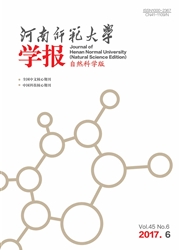

 中文摘要:
中文摘要:
Accurate estimate of soil carbon storage is essential to reveal the role of soil in global carbon cycle. However, there is large uncertainty on the estimation of soil organic carbon(SOC) storage in grassland among previous studies, and the study on soil inorganic carbon(SIC) is still lack. We surveyed 153 sites during plant peak growing season and estimated SOC and SIC for temperate desert, temperate steppe, alpine steppe, steppe meadow, alpine meadow and swamp, which covered main grassland in the Qinghai Plateau during 2011 to 2012. The results showed that the vertical and spatial distributions of SOC and SIC varied by grassland types. The SOC amount mainly decreased from southeast to northwest, whereas the SIC amount increased from southeast to northwest. The magnitude of SOC amount in the top 50 cm across grassland types ranked by: swamp > alpine meadow >steppe meadow > temperate steppe > alpine steppe > temperate desert, while the SIC amount showed an opposite order. There was a great deal of variation in proportion of SOC and SIC among different grassland types(from 55.17 to 94.59 for SOC and 5.14 to 44.83 for SIC). The total SOC and SIC storage was 5.78 Pg and 1.37 Pg, respectively, in the top 50 cm of soil in Qinghai Province. The mixed linear model revealed that grassland types was the predominant factor in spatial variations of SOC amount while grassland types and soil p H accounted for those of SIC amount. Our results suggested that the community shift of alpine meadow towards alpine grassland induced by climate warming would decrease carbon sequestration capacity by 6.0 kg C m2.
 英文摘要:
英文摘要:
Accurate estimate of soil carbon storage is essential to reveal the role of soil in global carbon cycle. However, there is large uncertainty on the estimation of soil organic carbon(SOC) storage in grassland among previous studies, and the study on soil inorganic carbon(SIC) is still lack. We surveyed 153 sites during plant peak growing season and estimated SOC and SIC for temperate desert, temperate steppe, alpine steppe, steppe meadow, alpine meadow and swamp, which covered main grassland in the Qinghai Plateau during 2011 to 2012. The results showed that the vertical and spatial distributions of SOC and SIC varied by grassland types. The SOC amount mainly decreased from southeast to northwest, whereas the SIC amount increased from southeast to northwest. The magnitude of SOC amount in the top 50 cm across grassland types ranked by: swamp 〉 alpine meadow 〉steppe meadow 〉 temperate steppe 〉 alpine steppe 〉 temperate desert, while the SIC amount showed an opposite order. There was a great deal of variation in proportion of SOC and SIC among different grassland types(from 55.17 to 94.59 for SOC and 5.14 to 44.83 for SIC). The total SOC and SIC storage was 5.78 Pg and 1.37 Pg, respectively, in the top 50 cm of soil in Qinghai Province. The mixed linear model revealed that grassland types was the predominant factor in spatial variations of SOC amount while grassland types and soil p H accounted for those of SIC amount. Our results suggested that the community shift of alpine meadow towards alpine grassland induced by climate warming would decrease carbon sequestration capacity by 6.0 kg C m^2.
 同期刊论文项目
同期刊论文项目
 同项目期刊论文
同项目期刊论文
 The uptake diversity of soil nitrogen nutrients by main plant species in Kobresia humilis alpine mea
The uptake diversity of soil nitrogen nutrients by main plant species in Kobresia humilis alpine mea Effects of Seasonal changes of CO2, CH4 and N2O fluxes in different types of alpine grassland in the
Effects of Seasonal changes of CO2, CH4 and N2O fluxes in different types of alpine grassland in the Effects of short-term and long-term warming on soil nutrients, microbial biomass and enzyme activiti
Effects of short-term and long-term warming on soil nutrients, microbial biomass and enzyme activiti Using a cellular-automata model to investigate the effects of grazing on plateau pika population dyn
Using a cellular-automata model to investigate the effects of grazing on plateau pika population dyn GLOBAL STABILITY OF SIVS MODEL WITH SATURATION INCIDENCE, INFECTION AGE AND IMPULSIVE VACCINATED RAT
GLOBAL STABILITY OF SIVS MODEL WITH SATURATION INCIDENCE, INFECTION AGE AND IMPULSIVE VACCINATED RAT Permanence in Multispecies Nonautonomous Lotka-Volterra Competitive Systems with Delays and Impulses
Permanence in Multispecies Nonautonomous Lotka-Volterra Competitive Systems with Delays and Impulses Dynamics of Population Controlled with Virus-vectored Immunocontraception and Immunocontraception Ag
Dynamics of Population Controlled with Virus-vectored Immunocontraception and Immunocontraception Ag The Permanence and Extinction of the Single Species with Contraception Control and Feedback Controls
The Permanence and Extinction of the Single Species with Contraception Control and Feedback Controls Mesoporous Carbon as a Metal-Free Catalyst for the Reduction of Nitroaromatics with Hydrazine Hydrat
Mesoporous Carbon as a Metal-Free Catalyst for the Reduction of Nitroaromatics with Hydrazine Hydrat Effects of warming and grazing on soil N availability, species composition, and ANPP in an alpine me
Effects of warming and grazing on soil N availability, species composition, and ANPP in an alpine me Response of soil properties to yak grazing intensity in a Kobresia parva-meadow on the Qinghai-Tibet
Response of soil properties to yak grazing intensity in a Kobresia parva-meadow on the Qinghai-Tibet Field (CO2)-C-13 pulse labeling reveals differential partitioning patterns of photoassimilated carbo
Field (CO2)-C-13 pulse labeling reveals differential partitioning patterns of photoassimilated carbo Seasonal and interannual variations of ecosystem photosynthetic features in an alpine dwarf shrublan
Seasonal and interannual variations of ecosystem photosynthetic features in an alpine dwarf shrublan Above- and Belowground Response along Degradation Gradient in an Alpine Grassland of the Qinghai-Tib
Above- and Belowground Response along Degradation Gradient in an Alpine Grassland of the Qinghai-Tib Non-additive effect of species diversity and temperature sensitivity of mixed litter decomposition i
Non-additive effect of species diversity and temperature sensitivity of mixed litter decomposition i 期刊信息
期刊信息
